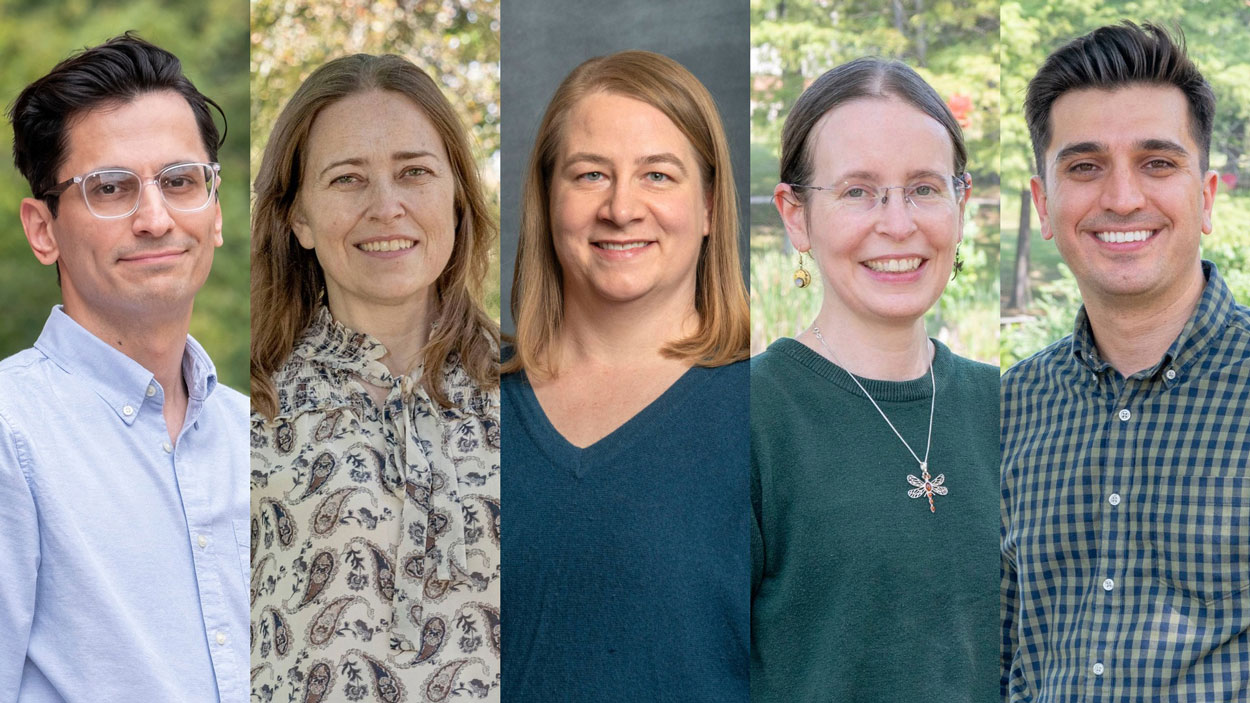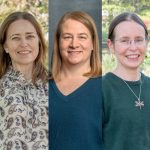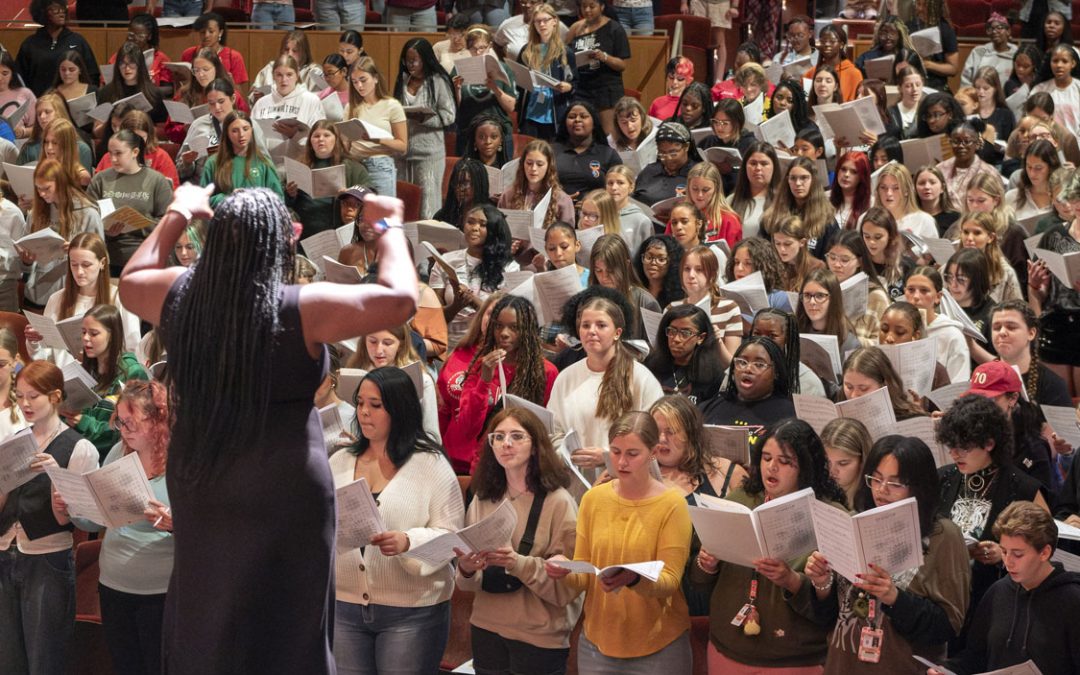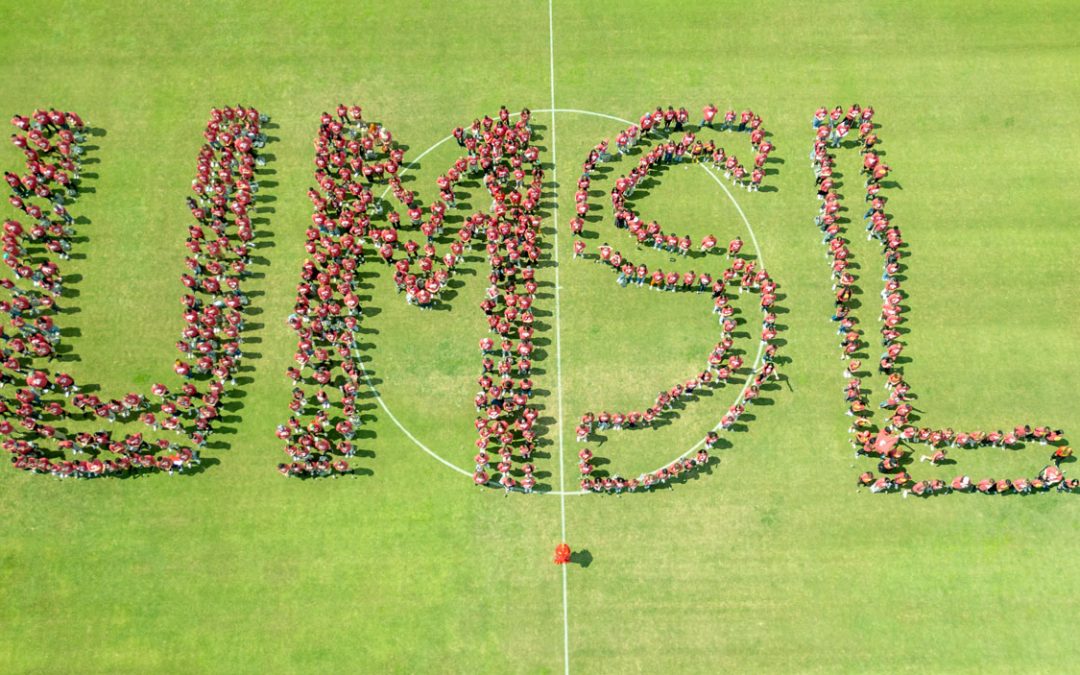
Faculty members (from left) Azim Ahmadzadeh, Jalene LaMontagne, Sara Miller, Erika Gibb and Mohi Saki have each recently received grants from the National Science Foundation to support their research. (Photos by Derik Holtmann)
The National Science Foundation has recently awarded four grants totaling more than $1.9 million to researchers at the University of Missouri–St. Louis.
Faculty members Azim Ahmadzadeh in the Department of Computer Science, Jalene LaMontagne and Sara Miller in the Department of Biology, and Erika Gibb and Mohi Saki in the Department of Mathematics, Physics, Astronomy and Statistics each received approval for funding to support their important work in the past three months.
“NSF funding is extremely competitive,” said Christopher Spilling, UMSL’s vice chancellor for research and economic and community development. “I am extremely proud of this group of faculty members for their innovative research and persistence in securing NSF funding.”
Ahmadzadeh, an assistant professor, received a $558,316 grant for a project titled “Large-Scale Analysis of Filaments’ Magnetic Evolution from Curated Ground-based Observations.”
LaMontagne, the E. Desmond Lee Endowed Professor in Botanical Studies, received a $654,638 grant through NSF’s Division of Environmental Biology and the Innovative Use of Scientific Collections program for a project titled “Using the past, present and future to investigate the effects of global change agents on tree reproduction across the boreal forest.”
Miller, an assistant professor, received a $486,982 grant for a project titled “Assessment of character displacement in cooperatively nesting wasps.”
Gibb, a professor and department chair, and Saki, an assistant teaching professor, received a $226,954 grant for their project, “Transformative studies of cometary volatiles in the era of modern near-infrared spectrographs.”
Learn more about each of their projects:
Azim Ahmadzadeh
Ahmadzadeh is an interdisciplinary researcher, using advanced computing to study astrophysics and space weather. In this project, he’s collaborating with a physicist at the New Jersey Institute of Technology and attempting to home in on filaments, which are prominent structures in the sun’s chromosphere that consist of cool, dense plasma suspended in the hot solar corona by magnetic fields. He’s hoping to learn more about how they’re formed, progress and disappear.
Filament eruptions often lead to coronal mass ejections, which send billions of tons of material from the Sun’s outer atmosphere into space at high speeds and can impact the Earth’s magnetosphere with the potential to disrupt power grids and communication systems while creating auroras.
“There is really nothing that we can do to prevent it,” Ahmadzadeh said. “It is costly, but it’s not too difficult to minimize the damage. For example, for a power grid, you can just shut off the power grid before it hits us. Of course, shutting down the power grid of a large city is already a big decision to make, but that could save a lot of our infrastructure.”
Space weather forecasting can lead to better preparation for these events. With his project, Ahmadzadeh will be tracking solar events and analyzing millions of images collected from a network of six ground-based observatories over two decades, and he plans to deploy machine learning to recognize patterns that exist.
“These are patterns that physicists understand, but not in such a large scale,” Ahmadzadeh said. “Physicists have been doing a great job in looking at individual events and seeing that in the next five days, six days, whether they erupt or they just die, but those are anecdotal evidence. Now we want to look at as many as those events as we can get to so that we should be able to identify them automatically and be able to track them from one observation to another.”
The goal is to predict solar events and minimize damage by providing early warnings to governments and infrastructure managers.
Jalene LaMontagne
Boreal forests cover roughly 30% of the Earth’s forested areas and play an important role in regulating global climate while storing massive amounts of carbon. They also provide critical habitat for numerous species of plants and animals and supply resources for sustainable growth. But these forests have been increasingly under threat from factors linked to climate change, including increasing fires, droughts and changing temperatures.
Previous studies have examined effects of environmental changes on tree growth and shifts in the range of species in boreal forests. LaMontagne and her primary collaborators at the University of Connecticut and the University of Oregon are working to fill a key gap in knowledge by exploring how abiotic factors such as temperature, precipitation, nitrogen availability, and fire, impact tree reproduction.
“We’re interested in five dominant species of the boreal forest (white spruce, black spruce, eastern tamarack, balsam fir and jack pine), some of which occur all the way from the West Coast to the East Coast,” LaMontagne said. “Some of them are adapted to fire, and some aren’t. Some like wetter areas, some like drier areas, but they’re all conifer trees. We’re interested in asking how all these global change drivers are affecting the reproduction of trees and the quality of seeds that are produced. We want to use that information that we’re going to get to make projections into the future across really large landscapes.”
The vastness of boreal forests makes this challenging, but with the help of a network of other researchers, they plan to collect new specimens from 43 sites across North America, ranging from Alaska to Newfoundland. They will test how carbon dioxide levels, temperature, water availability, nitrogen deposition and wildfire are interacting to affect the quantity and quality of seeds. The research should inform government agencies about the drivers of seed production and viability.
LaMontagne, who has a dual appointment as a principal investigator with the Missouri Botanical Garden, plans to add cone specimens from North American boreal forests to the Garden’s Herbarium.
She expects this project will provide learning and research opportunities for three graduate students and six undergraduates as well as a youth training program.
Sara Miller
Miller’s research works at the intersection of genomics, behavior and ecology as they shape biological diversity. Her lab works primarily with paper wasps, which are a particularly good model for studying social behavior, and it explores drivers of speciation and diversification.
Through her project, Miller is aiming to examine how the number of species of paper wasps that live in a community impact each other.
“With areas where there are a lot of species around, are animals behaving differently?” Miller said. “Do they have smaller niches than animals in areas where there are only a few species around? Wasps, in general, have been a very impactful invasive species, so we want to know if you get another wasp species that comes into the area, does it have major consequences for the species that already live there or is it not really a big deal?”
Those questions are particularly prescient because humans have been moving species around through globalization, and the range of species has been drifting northward as climate changes.
Miller’s study will compare wasp species diversity in St. Louis as well as in Louisiana and Wisconsin. There are as many as 10 species living in Louisiana, five or six that can be found in St. Louis and only one species native to Wisconsin.
“It provides a nice natural history experimental study where we have some regions with really high species diversity, some regions with intermediate species diversity, and some regions with low species diversity,” Miller said.
Miller’s project is being funded through NSF’s Building Research Capacity of New Faculty in Biology program, which is aimed at helping junior faculty members build independent research programs. Through this project, Miller expects to provide research opportunities for UMSL students by creating nine paid undergraduate research positions and integrating research activities into a newly created entomology course for upper-level biology students involving local organizations and archiving collected insects.
Erika Gibb and Mohi Saki
Gibb and Saki have been conducting NSF-funded research on comets for years. Gibb, a professor and department chair as well as the chair of the Faculty Senate, recalled receiving her first comet-related NSF grant in 2009.
They’ve been drawn to this research because of what comets can teach them about the history of the solar system.
“Comets are basically dirty snowballs that formed in the beginning of the solar system, and they’ve been stored in the outer solar system ever since then,” Gibb said. “They should be the least modified objects in the solar system, so we should be able to use them to infer conditions in the early solar system. That’s what we’re trying to do.”
But before they can make any inferences, they have to sample a lot of them and do so multiple times as they orbit the sun.
“There are two different types of comets that we’re interested in,” said Saki, an assistant teaching professor. “The first type is called Jupiter-family comets mostly influenced by Jupiter. They have short orbital periods, meaning that in a matter of few decades, they go around the sun multiple times. On the other hand, we have long-period comets as well. Those are called Oort Cloud comets. They have thousands of years per orbital period, so they don’t get that frequent, repeated heat from the sun. One big question is whether there are any compositional differences between these two classes of comets.”
The next several months will provide a series of favorable cometary apparitions – the periods when a comet is visible from Earth – and they intend to take advantage of those opportunities to study their composition. The project will make use of high-resolution, near-infrared spectroscopic observations gathered by NASA’s Infrared Telescope Facility in Hawaii and the James Webb Space Telescope. They will be measuring distinct rotational-vibrational emissions from parent molecules released into the cloud of gas and dust surrounding the nucleus of the comets.














